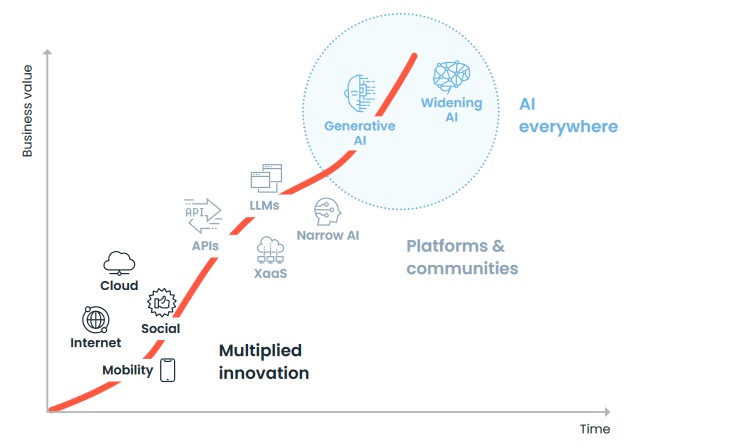
The banking industry is navigating a perfect storm: volatile markets, breakneck technological advancements, and relentless pressure to boost margins. At the same time, banks face increasing risks across cybersecurity, regulatory compliance, and operations.
Adding to this pressure, new research from ServiceNow and ThoughtLab reveals that less than 30% of banks feel their transformation efforts are meeting evolving customer digital needs. Additionally, 52% say they must revamp their strategy to counter competition from outside the sector. Adapting to these challenges isn't just about staying competitive — it's about staying in business.
To drive long-term success, now is the time to innovate. The research surveyed 1,125 executives from around the world to find out how much progress banks made driving AI-powered business transformation across their enterprises, and found that the banks prioritizing business transformation are leading the pack in achieving financial, operational, and strategic value.
Known as “Pacesetters,” this group of leaders is fostering growth by investing in advanced technology like artificial intelligence, automation, and end-to-end IT platforms. Let's explore how these innovative companies are staying ahead of the curve by examining where they are placing their biggest bets in 2025.
Safe, Secure, and Resilient Operations
Pacesetters are doubling down on customer privacy and security, with 54% saying it's a top priority — and they're leveraging cutting-edge technology to do so. Nearly half are employing AI across their operations to support fraud detection, compliance and regulatory measures, risk management, and cybersecurity.
For instance, with AI-driven systems in place, a bank could monitor transaction volumes and detect unusual patterns, such as a sudden spike in login attempts from a known high-risk location. By flagging this activity in real-time, the bank would have the ability to freeze access to potentially compromised accounts immediately, preventing unauthorized transactions and protecting sensitive customer data.
Similarly, AI can support compliance by continuously scanning through transaction records for anomalies that may raise regulatory concerns. If AI detects incomplete or incorrect data entries, it can alert compliance teams to correct these issues proactively, ensuring the bank stays in line with evolving regulatory standards.
Our research shows that this strategy is paying off, as 84% of Pacesetters have made significant progress strengthening their digital defenses, benefiting from AI's ability to identify risks and close security gaps before they become larger threats.
Streamlined and Integrated Customer Experiences
Pacesetters understand that building deep relationships and customer loyalty begins with seamless user journeys. In our survey, 94% said they're using generative AI to reduce friction and offer more personalized experiences, and 41% are using new technology to ensure seamless banking across mobile, website, and email.
Imagine receiving a text from your bank about an unauthorized charge and having to call to dispute it. While the bank investigates, you're left waiting for weeks or even months with a frozen, unusable card. On the bank's side, handling disputes triggers complex, manual processes involving compliance and merchant verification, which are costly and time-consuming.
Banks should implement solutions that handle transaction disputes efficiently, prevent issues from escalating, and streamline information management — enhancing the customer experience while simplifying bankers' tasks simultaneously.
For instance, omnichannel banking allows a customer to quickly report a questionable purchase or discrepancy, seek support and trigger an investigation from a live representative through the bank's help center, and finally, resolve the issue. Throughout the process, AI keeps the data and conversation history accessible and secure across all channels, while providing alerts so the customer doesn't have to repeat information or feel out of the loop.
Customer expectations have never been higher, and AI is helping banks meet the demand for connected, personalized journeys, building a more trusted, frictionless, and integrated customer experience across all touchpoints.
Connected Communication Across the Organization
Lastly, we found that the banks at the forefront of business transformation are using technology to streamline operations and bring teams together. In fact, 82% of Pacesetters are harnessing cloud, SaaS, and other digital solutions to scale business processes and foster cross-functional collaboration and feedback.
For instance, when a customer applies for a mortgage, a bank can utilize a centralized collaboration platform that connects loan officers, underwriters, and customer service representatives. As the loan officer processes the application, they can communicate directly with underwriters to resolve any questions or issues quickly, reducing bottlenecks. If the customer reaches out for updates, the customer service representative can access the application status in real-time and provide accurate, timely information without delay.
Another example is an investment banking firm that improved trade processing efficiency through a solution that created connected communication across the organization, linking systems of record for seamless task management. This eliminated reliance on shared email sorting and manual classification, providing better oversight, an audit trail, and instant visibility of settled trades. The result was a more efficient process that minimized risk, managed volume surges, and reduced capital costs without increasing staff.
By tapping into cloud-based collaboration tools, banks can break down silos between departments to foster more transparent communication and speed up processes. Effective collaboration allows organizations to quickly adapt and grow, which is crucial for navigating high-speed markets and increased competition.
Digital Innovation Is Transforming Banking for Tomorrow
Our data highlights that industry leaders are setting new standards by using advanced technology to prioritize customer privacy and security, strengthen customer experiences, and implement connectivity across systems, processes, people, and departments.
But where does one start this transformation journey? It begins with an AI platform that connects every part of the organization. This technology not only streamlines data management but also fosters seamless collaboration across teams, ensuring that customer inquiries and needs are addressed promptly.
Yet, technology is just one piece of the puzzle. Banks need a strategic approach that centers around their people — both employees and customers. This means nurturing a culture of innovation where teams feel empowered to embrace new tools and share insights, all while staying aligned with the bank's goals. By doing so, banks can create a collaborative environment that thrives on agility and customer-centricity.





